Android 14에는 개발자를 위한 훌륭한 기능과 API가 도입되었습니다. 다음은 앱의 기능을 알아보고 관련 API를 시작하는 데 도움이 됩니다.
추가된 API, 수정된 API, 삭제된 API에 관한 자세한 목록은 API 차이점 보고서를 참고하세요. 추가된 API에 관한 자세한 내용은 Android API 참조를 참고하세요. Android 14의 경우 API 수준 34에 추가된 API를 찾아보세요. 플랫폼 변경이 앱에 영향을 줄 수 있는 분야에 관해 알아보려면 Android 14를 타겟팅하는 앱 및 모든 앱의 Android 14 동작 변경사항을 확인해야 합니다.
다국어 지원
앱별 언어 설정
Android 14 expands on the per-app language features that were introduced in Android 13 (API level 33) with these additional capabilities:
Automatically generate an app's
localeConfig: Starting with Android Studio Giraffe Canary 7 and AGP 8.1.0-alpha07, you can configure your app to support per-app language preferences automatically. Based on your project resources, the Android Gradle plugin generates theLocaleConfigfile and adds a reference to it in the final manifest file, so you no longer have to create or update the file manually. AGP uses the resources in theresfolders of your app modules and any library module dependencies to determine the locales to include in theLocaleConfigfile.Dynamic updates for an app's
localeConfig: Use thesetOverrideLocaleConfig()andgetOverrideLocaleConfig()methods inLocaleManagerto dynamically update your app's list of supported languages in the device's system settings. Use this flexibility to customize the list of supported languages per region, run A/B experiments, or provide an updated list of locales if your app utilizes server-side pushes for localization.App language visibility for input method editors (IMEs): IMEs can utilize the
getApplicationLocales()method to check the language of the current app and match the IME language to that language.
Grammatical Inflection API
30억 명의 사용자가 성별이 지정된 언어를 사용합니다. 이 언어는 이야기하는 사람과 사물의 성별에 따라 문법적 카테고리(예: 명사, 동사, 형용사, 전치사)가 영향을 받는 언어입니다. 일반적으로 성별이 지정된 많은 언어에서 남성형 문법적 성별을 기본 성별이나 일반 성별로 사용합니다.
여성을 남성형 문법적 성별로 언급하는 등 잘못된 문법적 성별로 사용자를 언급하면 사용자의 실적과 태도에 부정적인 영향을 미칠 수 있습니다. 반면 사용자의 문법적 성별을 올바르게 반영하는 언어로 된 UI는 사용자 참여를 개선하고 보다 맞춤설정되고 자연스러운 사용자 환경을 제공할 수 있습니다.
성별이 지정된 언어의 사용자 중심 UI를 빌드할 수 있도록 Android 14에서는 앱 리팩터링 없이 문법적 성별에 관한 지원을 추가할 수 있는 Grammatical Inflection API를 도입합니다.
지역 설정
Regional preferences enable users to personalize temperature units, the first day of the week, and numbering systems. A European living in the United States might prefer temperature units to be in Celsius rather than Fahrenheit and for apps to treat Monday as the beginning of the week instead of the US default of Sunday.
New Android Settings menus for these preferences provide users with a
discoverable and centralized location to change app preferences. These
preferences also persist through backup and restore. Several APIs and
intents—such as
getTemperatureUnit
and
getFirstDayOfWeek—
grant your app read access to user preferences, so your app can adjust how it
displays information. You can also register a
BroadcastReceiver on
ACTION_LOCALE_CHANGED
to handle locale configuration changes when regional preferences change.
To find these settings, open the Settings app and navigate to System > Languages & input > Regional preferences.

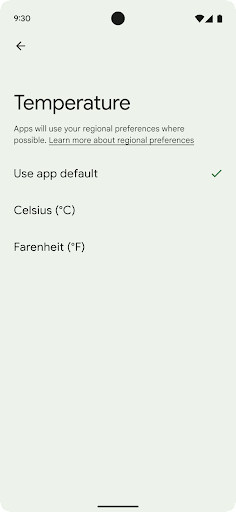
접근성
비선형 글꼴 크기 200%로 조정
Android 14부터 시스템은 최대 200%의 글꼴 크기 조정을 지원하며 웹에 맞는 추가 접근성 옵션을 제공하는 저시력 사용자 콘텐츠 접근성 가이드라인 (WCAG)
화면의 큰 텍스트 요소가 너무 커지지 않도록 비선형 조정 곡선을 적용합니다. 이 크기 조정 전략은 큰 텍스트가 작은 텍스트와 동일한 비율로 조정되지 않음을 의미합니다. 비선형 글꼴 크기 조정은 다양한 크기의 요소 간에 비례 계층 구조를 유지하는 동시에 높은 수준으로 크기가 조정되는 선형 텍스트 문제(예: 텍스트가 잘리거나 너무 큰 디스플레이 크기로 인해 텍스트를 읽기 어려워지는 경우)를 완화하는 데 도움이 됩니다.
비선형 글꼴 크기 조정으로 앱 테스트
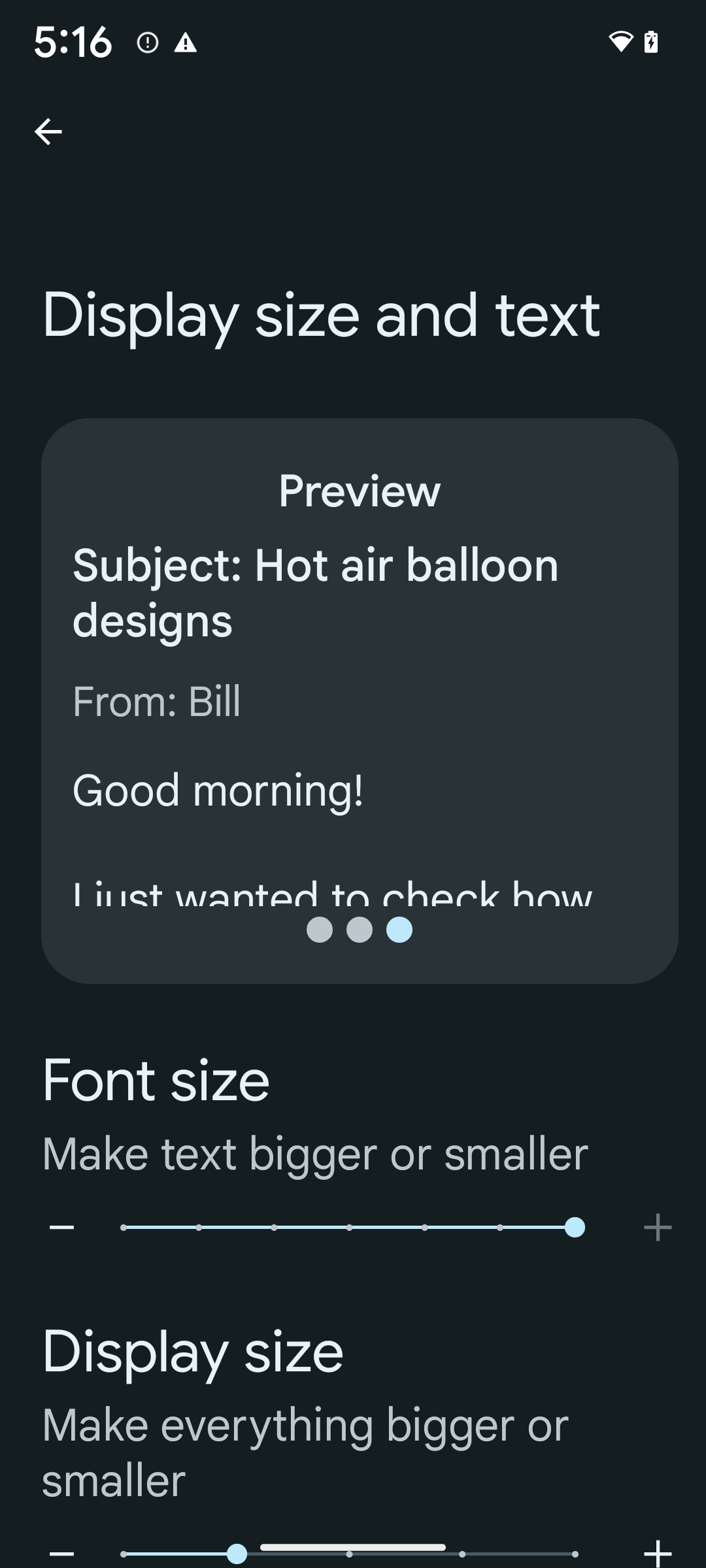
이미 조정된 픽셀 (sp) 단위를 사용하여 텍스트 크기 조정을 정의하는 경우 추가 옵션 및 확장 개선사항이 자동으로 사용할 수 있습니다. 그러나 여전히 최대한 많은 수의 앱이 글꼴 크기를 적용하도록 글꼴 크기 사용 설정 (200%) 사용성에 영향을 주지 않으면서 더 큰 글꼴 크기를 수용할 수 있어야 합니다.
200% 글꼴 크기를 사용 설정하려면 다음 단계를 따르세요.
- 설정 앱을 열고 접근성 > 디스플레이 크기 및 텍스트로 이동합니다.
- 글꼴 크기 옵션의 경우 이 섹션에 제공되는 이미지와 같이 최대 글꼴 크기 설정이 사용 설정될 때까지 더하기(+) 아이콘을 탭합니다.
텍스트 크기에 조정된 픽셀(sp) 단위 사용
항상 sp 단위로 텍스트 크기를 지정해야 합니다. 앱에서 sp 단위를 사용하면 Android에서는 사용자의 기본 텍스트 크기를 적용하고 적절하게 크기를 조정할 수 있습니다.
암시적 패딩을 가정하는 경우 패딩에 sp 단위를 사용하거나 뷰 높이를 정의하지 마세요. 비선형 글꼴 크기 조정 sp 치수는 비례하지 않을 수 있으므로 4sp + 20sp는 24sp와 다를 수 있습니다.
조정된 픽셀(sp) 단위 변환
TypedValue.applyDimension()를 사용하여 sp 단위에서 변환
픽셀로 변환하고 TypedValue.deriveDimension()를 사용하여
픽셀을 sp로 변환 이러한 방법은 인코더-디코더에 적절한 비선형 배율을
자동으로 곡선을 만듭니다.
수식을 하드코딩하지 마세요.
Configuration.fontScale 또는
DisplayMetrics.scaledDensity 글꼴 크기 조정이 비선형이므로 scaledDensity 필드가 더 이상 정확하지 않습니다. 글꼴이 더 이상 단일 스칼라 값으로 크기가 조정되지 않으므로 fontScale 필드는 정보 제공용으로만 사용해야 합니다.
lineHeight에 sp 단위 사용
항상 dp 대신 sp 단위를 사용하여 android:lineHeight를 정의하세요. 그러면 행 간격이 텍스트와 함께 조정됩니다. 또는 텍스트가
sp이지만 lineHeight이 dp 또는 px인 경우 크기가 조정되지 않고 비좁아 보입니다.
TextView는 의도한 대로 lineHeight를 자동으로 수정합니다.
비율은 유지되지만 textSize 및 lineHeight이 모두
sp 단위로 정의됩니다.
카메라 및 미디어
이미지용 울트라 HDR
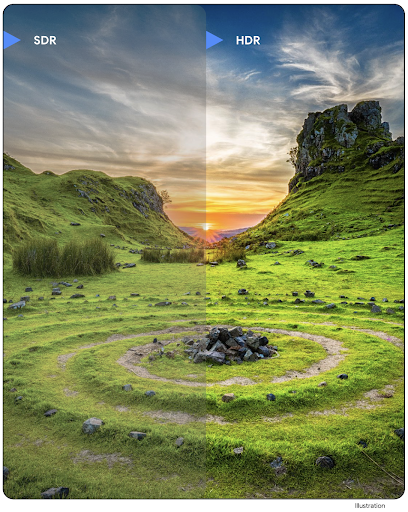
Android 14 adds support for High Dynamic Range (HDR) images that retain more of the information from the sensor when taking a photo, which enables vibrant colors and greater contrast. Android uses the Ultra HDR format, which is fully backward compatible with JPEG images, allowing apps to seamlessly interoperate with HDR images, displaying them in Standard Dynamic Range (SDR) as needed.
Rendering these images in the UI in HDR is done automatically by the framework
when your app opts in to using HDR UI for its Activity Window, either through a
manifest entry or at runtime by calling
Window.setColorMode(). You can also capture compressed Ultra
HDR still images on supported devices. With more colors recovered
from the sensor, editing in post can be more flexible. The
Gainmap associated with Ultra HDR images can be used to render
them using OpenGL or Vulkan.
카메라 확장 프로그램의 확대/축소, 초점, Postview 등
Android 14 upgrades and improves camera extensions, allowing apps to handle longer processing times, which enables improved images using compute-intensive algorithms like low-light photography on supported devices. These features give users an even more robust experience when using camera extension capabilities. Examples of these improvements include:
- Dynamic still capture processing latency estimation provides much more
accurate still capture latency estimates based on the current scene and
environment conditions. Call
CameraExtensionSession.getRealtimeStillCaptureLatency()to get aStillCaptureLatencyobject that has two latency estimation methods. ThegetCaptureLatency()method returns the estimated latency betweenonCaptureStartedandonCaptureProcessStarted(), and thegetProcessingLatency()method returns the estimated latency betweenonCaptureProcessStarted()and the final processed frame being available. - Support for capture progress callbacks so that apps can display the current
progress of long-running, still-capture processing operations. You can check
if this feature is available with
CameraExtensionCharacteristics.isCaptureProcessProgressAvailable, and if it is, you implement theonCaptureProcessProgressed()callback, which has the progress (from 0 to 100) passed in as a parameter. Extension specific metadata, such as
CaptureRequest.EXTENSION_STRENGTHfor dialing in the amount of an extension effect, such as the amount of background blur withEXTENSION_BOKEH.Postview Feature for Still Capture in camera extensions, which provides a less-processed image more quickly than the final image. If an extension has increased processing latency, a postview image could be provided as a placeholder to improve UX and switched out later for the final image. You can check if this feature is available with
CameraExtensionCharacteristics.isPostviewAvailable. Then you can pass anOutputConfigurationtoExtensionSessionConfiguration.setPostviewOutputConfiguration.Support for
SurfaceViewallowing for a more optimized and power-efficient preview render path.Support for tap to focus and zoom during extension usage.
인센서 줌
When REQUEST_AVAILABLE_CAPABILITIES_STREAM_USE_CASE in
CameraCharacteristics contains
SCALER_AVAILABLE_STREAM_USE_CASES_CROPPED_RAW, your app
can use advanced sensor capabilities to give a cropped RAW stream the same
pixels as the full field of view by using a CaptureRequest
with a RAW target that has stream use case set to
CameraMetadata.SCALER_AVAILABLE_STREAM_USE_CASES_CROPPED_RAW.
By implementing the request override controls, the updated camera gives users
zoom control even before other camera controls are ready.
무손실 USB 오디오
Android 14에서는 USB 유선 헤드셋을 통한 오디오필 수준의 환경을 위한 무손실 오디오 형식을 지원합니다. USB 기기에서 기본 믹서 속성을 쿼리하고, 기본 믹서 속성 변경에 관한 리스너를 등록하고, AudioMixerAttributes 클래스를 사용하여 믹서 속성을 구성할 수 있습니다. 이 클래스는 채널 마스크, 샘플링 레이트, 오디오 믹서의 동작과 같은 형식을 나타냅니다. 이 클래스를 사용하면 믹싱, 볼륨 조정 또는 효과 처리 없이 오디오를 직접 전송할 수 있습니다.
개발자 생산성 및 도구
인증 관리자
Android 14 adds Credential Manager as a platform API, with additional support back to Android 4.4 (API level 19) devices through a Jetpack Library using Google Play services. Credential Manager aims to make sign-in easier for users with APIs that retrieve and store credentials with user-configured credential providers. Credential Manager supports multiple sign-in methods, including username and password, passkeys, and federated sign-in solutions (such as Sign-in with Google) in a single API.
Passkeys provide many advantages. For example, passkeys are built on industry standards, can work across different operating systems and browser ecosystems, and can be used with both websites and apps.
For more information, see the Credential Manager and passkeys documentation and the blogpost about Credential Manager and passkeys.
헬스 커넥트
Health Connect is an on-device repository for user health and fitness data. It allows users to share data between their favorite apps, with a single place to control what data they want to share with these apps.
On devices running Android versions prior to Android 14, Health Connect is available to download as an app on the Google Play store. Starting with Android 14, Health Connect is part of the platform and receives updates through Google Play system updates without requiring a separate download. With this, Health Connect can be updated frequently, and your apps can rely on Health Connect being available on devices running Android 14 or higher. Users can access Health Connect from the Settings in their device, with privacy controls integrated into the system settings.
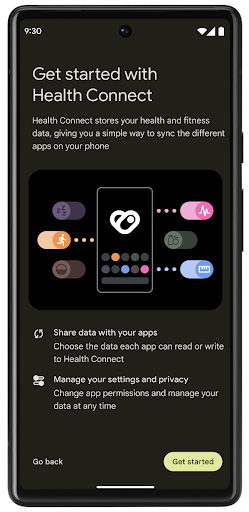
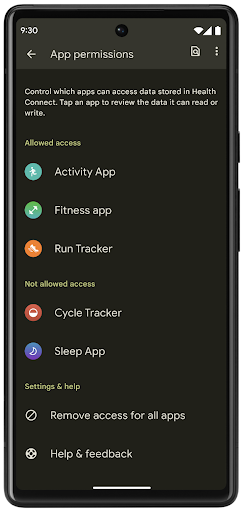
Health Connect includes several new features in Android 14, such as exercise routes, allowing users to share a route of their workout which can be visualized on a map. A route is defined as a list of locations saved within a window of time, and your app can insert routes into exercise sessions, tying them together. To ensure that users have complete control over this sensitive data, users must allow sharing individual routes with other apps.
For more information, see the Health Connection documentation and the blogpost on What's new in Android Health.
OpenJDK 17 업데이트
Android 14 continues the work of refreshing Android's core libraries to align with the features in the latest OpenJDK LTS releases, including both library updates and Java 17 language support for app and platform developers.
The following features and improvements are included:
- Updated approximately 300
java.baseclasses to Java 17 support. - Text Blocks, which introduce multi-line string literals to the Java programming language.
- Pattern Matching for instanceof, which allows an object to
be treated as having a specific type in an
instanceofwithout any additional variables. - Sealed classes, which allow you restrict which classes and interfaces can extend or implement them.
Thanks to Google Play system updates (Project Mainline), over 600 million devices are enabled to receive the latest Android Runtime (ART) updates that include these changes. This is part of our commitment to give apps a more consistent, secure environment across devices, and to deliver new features and capabilities to users independent of platform releases.
Java and OpenJDK are trademarks or registered trademarks of Oracle and/or its affiliates.
앱 스토어 개선사항
Android 14에서는 앱 스토어에서 사용자 환경을 개선할 수 있는 여러 PackageInstaller API를 도입했습니다.
다운로드하기 전에 설치 승인 요청
앱을 설치하거나 업데이트하려면 사용자 승인이 필요할 수 있습니다.
예를 들어 REQUEST_INSTALL_PACKAGES 권한을 사용하는 설치 프로그램이 새 앱을 설치하려고 할 때를 예로 들 수 있습니다. 이전 Android 버전에서는 APK가 설치 세션에 기록되고 세션이 커밋된 후에만 앱 스토어에서 사용자 승인을 요청할 수 있습니다.
Android 14부터 requestUserPreapproval() 메서드를 사용하면 설치 프로그램이 설치 세션을 커밋하기 전에 사용자 승인을 요청할 수 있습니다. 이러한 개선을 통해 사용자가 설치를 승인할 때까지 앱 스토어에서 APK 다운로드를 연기할 수 있습니다. 또한 사용자가 설치를 승인하면 앱 스토어는 사용자를 방해하지 않고 백그라운드에서 앱을 다운로드하여 설치할 수 있습니다.
향후 업데이트에 관한 책임 주장
setRequestUpdateOwnership() 메서드를 사용하면 설치 프로그램이 설치되는 앱의 향후 업데이트를 책임진다고 시스템에 알릴 수 있습니다. 이 기능은 업데이트 소유권 적용을 사용 설정합니다. 즉, 업데이트 소유자만 앱에 자동 업데이트를 설치할 수 있습니다. 업데이트 소유권 적용은 사용자가 예상되는 앱 스토어에서만 업데이트를 수신하도록 합니다.
업데이트를 설치하려면 INSTALL_PACKAGES 권한을 사용하는 설치 프로그램을 비롯한 다른 모든 설치 프로그램이 명시적인 사용자 승인을 받아야 합니다. 사용자가 다른 소스의 업데이트를 진행하기로 하면 업데이트 소유권이 손실됩니다.
방해가 되지 않는 시간에 앱 업데이트
앱 스토어는 일반적으로 활발히 사용되고 있는 앱은 업데이트하지 않으려고 합니다. 이 경우 앱의 실행 중인 프로세스가 종료되어 사용자가 하던 작업이 중단될 수 있기 때문입니다.
Android 14부터 InstallConstraints API를 사용하면 설치 프로그램이 적절한 시점에 앱 업데이트를 실행할 수 있습니다. 예를 들어 앱 스토어는 commitSessionAfterInstallConstraintsAreMet() 메서드를 호출하여 사용자가 더 이상 앱과 상호작용하지 않을 때만 업데이트가 커밋되도록 할 수 있습니다.
선택적 분할을 원활하게 설치
분할 APK를 사용하면 앱의 기능을 모놀리식 APK가 아닌 별도의 APK 파일로 제공할 수 있습니다. 분할 APK를 사용하면 앱 스토어에서 다양한 앱 구성요소의 전송을 최적화할 수 있습니다. 예를 들어 앱 스토어는 대상 기기의 속성을 기반으로 최적화할 수 있습니다. PackageInstaller API는 API 수준 22에 도입된 이후 분할을 지원했습니다.
Android 14에서 setDontKillApp() 메서드를 사용하면 설치 프로그램이 새 분할이 설치될 때 앱의 실행 중인 프로세스를 종료해서는 안 된다고 나타낼 수 있습니다. 앱 스토어는 이 기능을 사용하여 사용자가 앱을 사용하는 동안 앱의 새로운 기능을 원활하게 설치할 수 있습니다.
앱 메타데이터 번들
Android 14부터 Android 패키지 설치 프로그램을 사용하면 데이터 보안 관행과 같은 앱 메타데이터를 지정하여 Google Play와 같은 앱 스토어 페이지에 포함할 수 있습니다.
사용자가 기기 스크린샷을 찍을 때 감지
To create a more standardized experience for detecting screenshots, Android 14 introduces a privacy-preserving screenshot detection API. This API lets apps register callbacks on a per-activity basis. These callbacks are invoked, and the user is notified, when the user takes a screenshot while that activity is visible.
사용자 환경
Sharesheet 맞춤 작업 및 개선된 순위 지정
Android 14 updates the system sharesheet to support custom app actions and more informative preview results for users.
Add custom actions
With Android 14, your app can add custom actions to the system sharesheet it invokes.
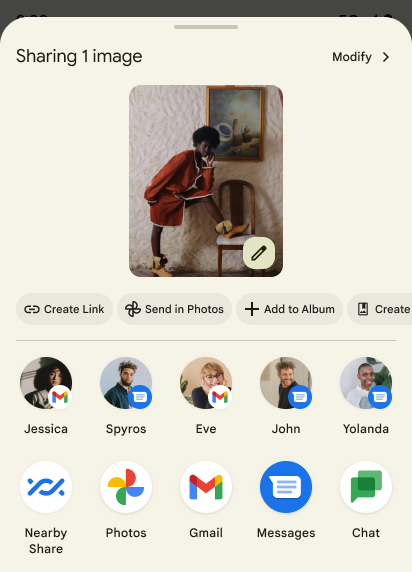
Improve ranking of Direct Share targets
Android 14 uses more signals from apps to determine the ranking of the direct share targets to provide more helpful results for the user. To provide the most useful signal for ranking, follow the guidance for improving rankings of your Direct Share targets. Communication apps can also report shortcut usage for outgoing and incoming messages.
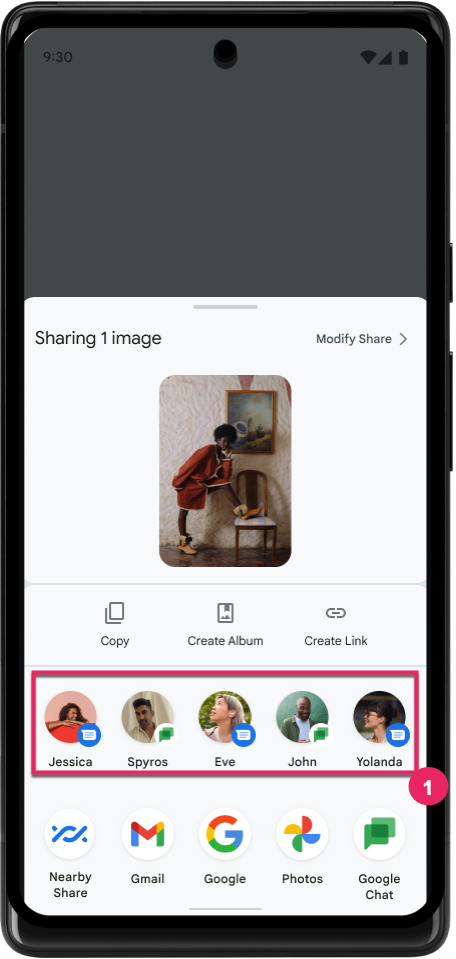
뒤로 탐색 예측을 위한 내장 및 맞춤 애니메이션 지원
Android 13 introduced the predictive back-to-home animation behind a developer option. When used in a supported app with the developer option enabled, swiping back shows an animation indicating that the back gesture exits the app back to the home screen.
Android 14 includes multiple improvements and new guidance for Predictive Back:
- You can set
android:enableOnBackInvokedCallback=trueto opt in to predictive back system animations per-Activity instead of for the entire app. - We've added new system animations to accompany the back-to-home animation from Android 13. The new system animations are cross-activity and cross-task, which you get automatically after migrating to Predictive Back.
- We've added new Material Component animations for Bottom sheets, Side sheets, and Search.
- We've created design guidance for creating custom in-app animations and transitions.
- We've added new APIs to support custom in-app transition animations:
handleOnBackStarted,handleOnBackProgressed,handleOnBackCancelledinOnBackPressedCallbackonBackStarted,onBackProgressed,onBackCancelledinOnBackAnimationCallback- Use
overrideActivityTransitioninstead ofoverridePendingTransitionfor transitions that respond as the user swipes back.
With this Android 14 preview release, all features of Predictive Back remain behind a developer option. See the developer guide to migrate your app to predictive back, as well as the developer guide to creating custom in-app transitions.
대형 화면 기기 제조업체 앱별 재정의
앱별 재정의를 사용하면 기기 제조업체가 대형 화면 기기에서 앱의 동작을 변경할 수 있습니다. 예를 들어 FORCE_RESIZE_APP 재정의는 앱 매니페스트에 resizeableActivity="false"가 설정되어 있더라도 디스플레이 크기에 맞게 앱의 크기를 조절하도록 시스템에 지시합니다 (크기 호환성 모드 피하기).
재정의는 대형 화면에서 사용자 환경을 개선하기 위한 것입니다.
새 매니페스트 속성을 사용하면 앱에 대한 일부 기기 제조업체 재정의를 사용 중지할 수 있습니다.
대형 화면 사용자 앱별 재정의
앱별 재정의는 대형 화면 기기에서 앱의 동작을 변경합니다. 예를 들어 OVERRIDE_MIN_ASPECT_RATIO_LARGE 기기 제조업체 재정의는 앱 구성과 관계없이 앱 가로세로 비율을 16:9로 설정합니다.
Android 14 QPR1을 사용하면 사용자가 대형 화면 기기에서 새 설정 메뉴를 통해 앱별 재정의를 적용할 수 있습니다.
앱 화면 공유
App screen sharing enables users to share an app window instead of the entire device screen during screen content recording.
With app screen sharing, the status bar, navigation bar, notifications, and other system UI elements are excluded from the shared display. Only the content of the selected app is shared.
App screen sharing improves productivity and privacy by enabling users to run multiple apps but limit content sharing to a single app.
Pixel 8 Pro의 Gboard에서 LLM 기반 스마트 답장
12월 기능 업데이트가 적용된 Pixel 8 Pro 기기에서 개발자는 Google Tensor에서 실행되는 온디바이스 대규모 언어 모델 (LLM)을 기반으로 하는 Gboard의 고품질 스마트 답장을 사용해 볼 수 있습니다.
이 기능은 WhatsApp, Line, KakaoTalk에서 미국 영어로 제한된 미리보기로 제공됩니다. Gboard를 키보드로 사용하는 Pixel 8 Pro 기기를 사용해야 합니다.
이 기능을 사용해 보려면 먼저 설정 > 개발자 옵션 > AiCore 설정 > Aicore Persistent 사용 설정에서 기능을 사용 설정하세요.
그런 다음 지원되는 앱에서 대화를 열어 수신 메시지에 대한 응답으로 Gboard의 추천 표시줄에 LLM 기반 스마트 답장이 표시되는지 확인합니다.
그래픽
이제 쿼리하고 보간할 수 있는 경로
Android의 Path API는 벡터 그래픽을 만들고 렌더링하기 위한 강력하고 유연한 메커니즘으로, 경로를 획 처리하거나 채우고, 선분이나 이차 또는 삼차 곡선으로 경로를 구성하고, 불리언 연산을 실행하여 훨씬 더 복잡한 도형을 가져오거나 이 모든 작업을 동시에 실행할 수 있습니다. 한 가지 제한사항은 경로 객체에 실제로 무엇이 있는지 찾을 수 있다는 것입니다. 객체의 내부는 생성 후 호출자에게 불투명합니다.
Path를 만들려면 moveTo(), lineTo(), cubicTo()와 같은 메서드를 호출하여 경로 세그먼트를 추가하세요. 그러나 이 경로에 세그먼트가 무엇인지 물어볼 방법이 없으므로 생성 시 해당 정보를 유지해야 합니다.
Android 14부터 경로를 쿼리하여 그 안에 포함된 항목을 확인할 수 있습니다.
먼저 Path.getPathIterator API를 사용하여 PathIterator 객체를 가져와야 합니다.
Kotlin
val path = Path().apply { moveTo(1.0f, 1.0f) lineTo(2.0f, 2.0f) close() } val pathIterator = path.pathIterator
자바
Path path = new Path(); path.moveTo(1.0F, 1.0F); path.lineTo(2.0F, 2.0F); path.close(); PathIterator pathIterator = path.getPathIterator();
그런 다음 PathIterator를 호출하여 세그먼트를 하나씩 반복하면서 각 세그먼트에 필요한 모든 데이터를 검색할 수 있습니다. 이 예에서는 데이터를 패키징하는 PathIterator.Segment 객체를 사용합니다.
Kotlin
for (segment in pathIterator) { println("segment: ${segment.verb}, ${segment.points}") }
자바
while (pathIterator.hasNext()) { PathIterator.Segment segment = pathIterator.next(); Log.i(LOG_TAG, "segment: " + segment.getVerb() + ", " + segment.getPoints()); }
PathIterator에는 포인트 데이터를 보유할 버퍼를 전달할 수 있는 비할당 버전의 next()도 있습니다.
Path 데이터 쿼리에 관한 중요한 사용 사례 중 하나는 보간 유형입니다. 예를 들어 서로 다른 두 경로 간에 애니메이션을 적용하거나 모핑할 수 있습니다. 이러한 사용 사례를 더욱 단순화하기 위해 Android 14에는 Path에 interpolate() 메서드도 포함되어 있습니다. 두 경로의 내부 구조가 같다고 가정하면 interpolate() 메서드는 보간된 결과를 사용하여 새 Path를 만듭니다. 이 예에서는 path 및 otherPath 사이의 도형이 중간(선형 보간 유형 0.5)인 경로를 반환합니다.
Kotlin
val interpolatedResult = Path() if (path.isInterpolatable(otherPath)) { path.interpolate(otherPath, .5f, interpolatedResult) }
자바
Path interpolatedResult = new Path(); if (path.isInterpolatable(otherPath)) { path.interpolate(otherPath, 0.5F, interpolatedResult); }
Jetpack graphics-path 라이브러리를 사용하면 이전 버전의 Android에서도 유사한 API를 사용할 수 있습니다.
버텍스 및 프래그먼트 셰이더가 있는 맞춤 메시
Android는 오랫동안 맞춤 음영 처리로 삼각형 메시 그리기를 지원해 왔지만 입력 메시 형식은 사전 정의된 몇 가지 속성 조합으로 제한되었습니다. Android 14에서는 삼각형 또는 삼각형 스트립으로 정의할 수 있고 원하는 경우 색인을 생성할 수 있는 커스텀 메시 지원을 추가했습니다. 이러한 메시는 커스텀 속성, 정점 행렬, 변경, AGSL로 작성된 정점 및 프래그먼트 셰이더로 지정됩니다.
정점 셰이더는 위치 및 색상과 같은 가변을 정의하는 반면, 프래그먼트 셰이더는 원하는 경우 일반적으로 정점 셰이더에서 만든 가변을 사용하여 픽셀의 색상을 정의할 수 있습니다. 색상이 프래그먼트 셰이더에서 제공되면 메시를 그릴 때 선택한 혼합 모드를 사용하여 현재 Paint 색상과 혼합됩니다. 유니폼을 프래그먼트 및 정점 셰이더에 전달하여 유연성을 높일 수 있습니다.
캔버스의 하드웨어 버퍼 렌더러
To assist in using Android's Canvas API to draw with
hardware acceleration into a HardwareBuffer, Android 14
introduces HardwareBufferRenderer. This API is
particularly useful when your use case involves communication with the system
compositor through SurfaceControl for low-latency
drawing.

